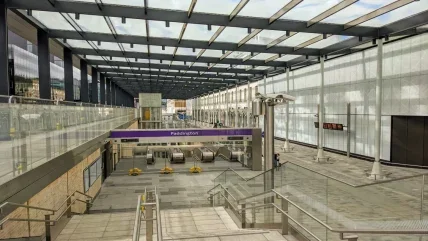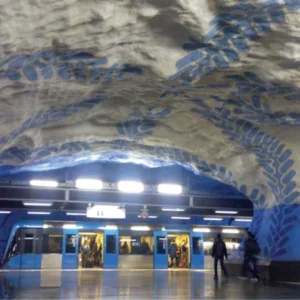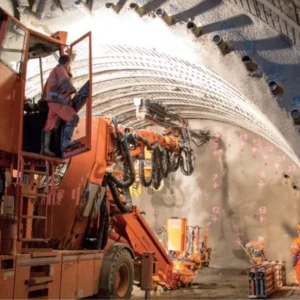
This briefing for T&T on the wealth of valuable material open to tunnellers has been prepared by Simon Bennett, former Head of Learning Legacy with Crossrail Ltd and now Associate Director and Expert Adviser, Stakeholder Engagement and Learning Legacy, with Crossrail International Ltd.
The Elizabeth line fully opened on Sunday the 21 May this year, when the service was increased to the full 24 trains per hour in each direction in the peak period. This was the final stage of a phased introduction which first saw trains serving the new central London stations from May 2022.
The new railway connects the existing railways to the east and west of London through 42km of tunnels in the central area and 10 new stations, eight of which are below ground. Construction started at Canary Wharf in 2009 and involved 39 Tier One contracts and two major Project Partners. The running tunnels were excavated between 2011 and 2015 by eight tunnel boring machines (TBMs) and the below ground stations were built using a variety of techniques, including top down box construction and sprayed concrete lining (SCL) undertaken in some cases as enlargement from the running tunnels, and in others as new excavation.
As the Crossrail programme is now complete, the organisation set up to deliver it has been demobilised but it’s not just the railway that remains as a result – Crossrail’s Learning Legacy is still available at: https://ll.crossrail.co.uk/
The Crossrail Learning Legacy Programme was established in 2015 with the objective to collate and share lessons learned, best practice and innovation from the Crossrail project for the benefit of future projects and programmes.
The Legacy Programme ran from mid-2015 to May 2023, with a hiatus between July 2018 and January 2020 while the project was reorganised to address delays. Up to 2018, 651 items were published in six 6-monthly tranches. This was over 25% more than the target the team set for itself. From 2020 the items were published as soon as available and the target of 25 new items was surpassed massively, with 159 added including those from a final technical papers competition and a third journal.
The establishment of a Learning Legacy was prompted by a recommendation to the Department for Transport (DfT) by the Public Accounts Committee (PAC) that the experience of delivering the Crossrail programme be shared for the benefit of other taxpayer funded projects. It followed in the footsteps of the London 2012 Olympic Delivery Authority’s Learning Legacy and involved sharing a combination of new and existing documentation through a dedicated website. The types of content include micro-reports, case studies and technical papers, all of which are items written for the Learning Legacy by those involved in delivery, and good practice documents and datasets, which are items produced during the work, such as processes and procedures and suites of data, which are shared for others to use, adapt or study.
In all there are 840 items on the site, arranged under the 12 Learning Legacy themes which reflect the functions of a typical major infrastructure project.
Most of the items of interest to readers of T&T will be in the Civil Engineering [https://ll.crossrail.co.uk/ learning-legacy-themes/engineering/civils/] topic area.
A large proportion of the technical papers in the Learning Legacy came from Crossrail’s annual Technical Papers competition. The competition encouraged colleagues from across the different organisations delivering the project to write up their experience, and each year the winning paper received recognition and all authors received a copy of the hardback book published in partnership with ICE Publishing.
There are dozens of papers from the competitions relating to tunnelling but a few highlights are:
- Tunnelling out of a drift filled hollow under Moorgate [https://ll.crossrail.co.uk/documents/tunnelling-driftfilled- hollow-moorgate/]
- Design and Construction of Inclined Escalator Shafts and Stair Adit at Liverpool Street and Whitechapel Stations [https://ll.crossrail.co.uk/ documents/design-construction-inclined-escalatorshafts- stair-adit-liverpool-st-whitechapel-stations/], and
- Comparison between Sprayed and Cast In-situ Concrete Secondary Linings at Bond Street and Farringdon Stations [https://ll.crossrail.co.uk/ documents/comparison-sprayed-cast-situ-concretesecondary- linings-bond-street-farringdon-stations/].
The Learning Legacy also produced three special issue journals, two with the ICE and one with the Association for Project Management (APM).
A paper entitled Machine-driven Tunnels on the Elizabeth line covers the TBM tunnelling [https:// ll.crossrail.co.uk/documents/crossrail-project-machinedriven- tunnels-elizabeth-line-london/].
Two papers cover the sprayed concrete work:
- Use of Sprayed Concrete Tunnel Linings on London’s Elizabeth line [https://ll.crossrail.co.uk/ documents/13005/], and,
- A Deep-mined Station on the Elizabeth line, London [https://ll.crossrail.co.uk/documents/deep-minedstation- elizabeth-line-london/].
Possibly one of the most useful recent additions is the archive of monitoring reports, which contain the results of instrument monitoring above the new station and running tunnels, this shows the movement of the ground in response to the excavations:
[https://ll.crossrail.co.uk/documents/instrumentationand- monitoring-close-out-reports/].But there is also a lot of content in the other engineering topics that will be of value to those working on major schemes, in particular the Systems Integration and Technical Assurance topic which contains all the experience of the challenges to integrate, test, commission and handover the railway. And beyond that, in the other themes, such as the Health and Safety, Environment, and the Project and Programme Management themes.
The baton has been picked up by HS2, which has its own learning legacy at https://learninglegacy.hs2.org.uk/ and we hope that other schemes and other industries will also follow.
Now that the Crossrail programme has closed, the Learning Legacy website will be maintained online at the same web address by Transport for London (TfL), but as a static site so that hosting costs are minimal. It is hoped that the experience shared in the Learning Legacy will help our industry improve project delivery for some time to come.






